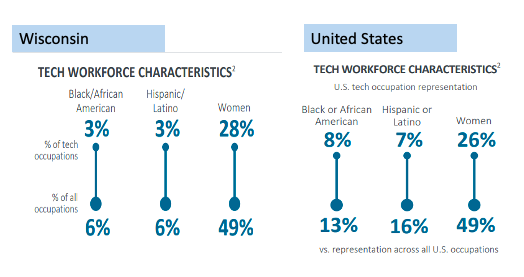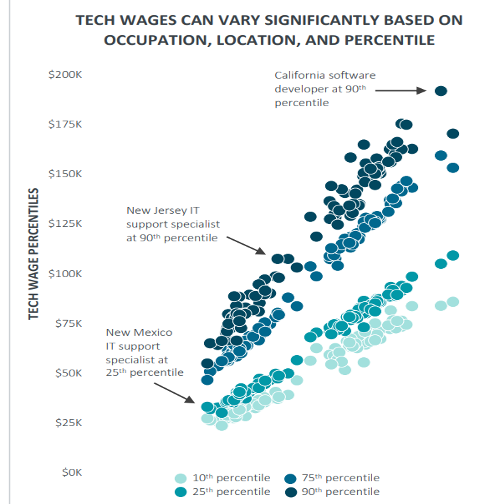Let’s start with a truth we all know, especially those of us who have been in the tech recruiting world for a while—tech talent is hard to find. And, the COVID-19 pandemic-induced digital transformation that many companies have been undergoing over the past 18 months has resulted in the need for even more of that talent. At the same time, those employees want to work remotely. Here are a few numbers for some context:
- There’s been a 100% increase in job postings offering remote and or hybrid work
- Only 17% of IT employees prefer full-time, on-site work
- 66% of IT employees prefer remote opportunities
- 44% of IT workers say they would quit their job if they weren’t offered a remote or hybrid working option
- 4.3 million: the number of workers who quit their jobs in August (nearly 3% of the entire workforce)
With these stats, it’s easy to see that it’s time to approach staffing differently—and making remote work a solid part of your retention and new hire strategy seems like a great place to start. If you’re looking to pivot into remote work or wanting to approach it in a different way, these considerations and strategies are a great starting point:
Consideration #1: Compensation isn’t about your location—it’s about theirs
Tech wages can vary significantly based on the type of role, location, and compensation percentile. However, remote workers are expecting pay to reflect their locations—not yours. The graph below (source: CompTIA CyberStates 2021 research report) illustrates this point perfectly. If you’re a company based in Wisconsin but hiring a software developer who lives in California and who’s at the top of their game, it’s essential to offer a salary that is set on local compensation factors, such as cost of labor and cost of living rates. We’re hearing of more employers adopting these “geographical pay” policies as a result. Work is no longer a singular, one-location place.
Consideration #2: Remote hiring and DEI initiatives go hand-in-hand
Companies that are inclusive, equitable, and diverse are a win/win/win—the more diverse your workforce, the more innovative and profitable you’ll be. Take a look at the graph below through the context of Wisconsin—according to the CompTIA CyberStates 2021 research report, we lag way behind in terms of representation in tech. Remote work is a powerful tool for making a company more diverse—expanding or removing geographical boundaries will not only increase diverse candidate pools, but it will also show outwardly that you’re truly committed to your DEI efforts. According to our research, over 70% of job seekers want to work for a company that demonstrates a commitment to DEI.
 Now that you know some of the considerations, what are the strategies? We’ve got three to consider when it comes to planning for remote work: fast and flexible hiring, cluster hiring, and workforce planning. We’ll take a deeper dive into each of these below:
Now that you know some of the considerations, what are the strategies? We’ve got three to consider when it comes to planning for remote work: fast and flexible hiring, cluster hiring, and workforce planning. We’ll take a deeper dive into each of these below:
Strategy #1: Fast and flexible hiring—and a focus on internal mobility
Last month, UPS announced they were planning to hire 100,000 employees—many of them in 30 minutes or less. While we’re not suggesting you hire with the same speed, we do suggest speeding up the process. Frequent and transparent communication about the process, limiting comparison candidates, and streamlining the interview process by pre-scheduling interviews and asking for quick responses from selection teams—all of these pieces can shave days or weeks off your timeline. Many potential employees simply won’t wait a month or more to hear about a job offer, no matter how compelling it might have been in the beginning.
Another strategy is to have a stronger retention strategy, especially as it relates to internal mobility. Replacing workers requires anywhere from one-half to two times an employee’s annual salary, according to Gallup’s State of the Global Workplace 2021 Report. In the same report, it was revealed that the lost productivity of “not engaged” and “actively disengaged” employees is equal to 18% of an employee’s annual salary. So, with an average salary of $50K, for example, it costs about $9,000/year to keep a disengaged worker and potentially create a more engaged employee, and between $25,000 to $100,000/year to replace them.
Strategy #2: Focus—and build your company’s brand—by focusing on cluster hiring
In sales and marketing, there’s a lot of talk about the disadvantages of “spray and pray” tactics—sending out generic, untargeted content, advertising, and sales pitches are quicker and easier than a targeted approach, but there’s a lack of quality or strategy that can ultimately hurt your efforts. Now, we’re not saying that you should apply this exact same thinking to recruiting—national recruiting is necessary and can yield results—but it never hurts to focus.
That’s why we recommend cluster hiring—doing the work to identify three to five cities or geographies, and focusing on those for specific types of roles or teams. This is advantageous for a few reasons:
- Helps your company build your brand in areas that weren’t aware of you before
- Makes good use of your recruiting and talent acquisition budget
- Identifies and leverages centers of influence
- After you hire a few employees in a specific area, you’ll have a better chance of leveraging an employee referral program, as when people refer someone they know for a role, chances are they’ll be recommending someone in their community
Strategy #3: Take the time for workforce planning
It may seem tempting to take a look at current needs and hire for those—but when you approach your hiring with a planning mindset, it’s easier to build your future workforce. Workforce planning is the process an organization uses to analyze its workforce and determine the steps it needs to take to prepare for future staffing needs.
When we work with partners on workforce planning, we encourage them to focus on three themes:
- Business Direction/Talent Demand Analysis: This is where a company needs to dive deep into its business objectives for the next 6-12 months and the internal and external factors that could cause its organizational strategy to change. What objectives are driving talent needs? Is there an organizational transformation underway that will require different skills from existing talent, and do you anticipate being able to use existing staff to complete those initiatives? Historically, do you have any positions that you’re constantly recruiting for due to turnover, or are there positions and locations that are difficult to find talent for?
- Talent Supply Analysis: This step concentrates on a company’s talent supply—analyzing pieces like annual attrition rate, budgetary assumed vacancy rate, the anticipation of layoffs or a reduction in force, and more. If you are anticipating layoffs, how does that impact your organization’s ability to acquire new talent? If you’ve identified needed positions, will internal or external factors cause the attrition rate to change in the coming year, and do you have a strategy to hire internal people for these needs? Are there any key positions at risk for future turnover that should have proactive recruitment and succession plans?
- Talent Gap Analysis: After you work through the first two parts of this analysis, it will be easier to see the gap between demand and supply, and you’ll be operating from a more strategic place in terms of workforce planning.
So, what does workforce planning have to do when considering remote workers? If you’re considering the talent supply in other geographies—for example, if you’re a company that needs to hire a lot of Python developers—you should do this analysis when considering where that talent currently resides. After you analyze the talent demand vs. supply, then you’re better set up to utilize the cluster hiring strategy we mentioned above.
Thinking through all of the elements of remote work can be tricky—we know it’s not as easy as just deciding to offer it as an option. If you’re in need of a partner as you navigate your own remote work path, we’re here to help—reach out anytime.


